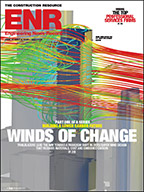 Mithun Portland used a carbon calculator when weighing whether to expand its light rail.
|
Green building experts are calling for more standard measures of greenhouse-gas emissions that can be used in the development of carbon calculators that quantify the impact of development on the environment. The tool is expected to become a mainstay in green-building design thanks to likely future legislation that will require developers to take carbon footprints into account.
A major limitation of some calculators, particularly those geared more toward consumers, has been the lack of consistency in quantifying greenhouse-gas emissions. “There are standards, but [carbon calculators are] all over the map right now. There’s a lot of smoke and mirrors, frankly,” says Wayne Trusty, president of Athena Institute, an Ontario-based nonprofit that consults on sustainability in the built environment.
Sources say calculators vary widely in level of sophistication and exactly what they measure, but experts involved in their design agree that the growing likelihood of enacting some sort of global-warming legislation or regulation will only heighten interest in measuring facilities’ carbon output, as well as other environmental impacts.
Calculators may measure embodied carbon, the carbon emitted while a building or facility is being constructed, or operational carbon, the carbon released to heat and cool a building, run electrical appliances, or both.
Washington state’s King County is currently developing a calculator that will measure embodied carbon, as well as operational emissions and emissions generated by cars and other vehicles.
The King County Council is considering a local ordinance that would enact greenhouse-gas emission mitigation requirements for developers beginning in 2009. Richard Gelb, performance measurement lead for the county’s Dept. of Natural Resources, says the ordinance is likely to be adopted, and the calculator could be useful to developers and designers in meeting the new requirements.
Another tool is Athena Institute’s Eco-Calculator for Assemblies. Athena is considered at the forefront of life-cycle assessment (LCA) study, which measures the environmental impacts of various building materials over a building’s life.
The calculator, which does not measure operational carbon, provides LCA with data for more than 400 common building assemblies including exterior walls, roofs, intermediate floors and interior walls. Calculations are based on the institute’s LCA databases of various building materials developed over the past two decades.
When the calculator is updated this summer, it will not only measure global warming potential, but other environmental parameters as well, such as fossil- fuel depletion, ozone depletion and acidification. “The EcoCalculator is designed to help more people incorporate environmental considerations at the conceptual stage of a project, when most critical decisions are made,” says Trusty.
The calculator has caught the attention of the U.S. Green Buildings Council, which is planning on integrating the tool into its Leadership in Energy and Environmental Design (LEED) certification program. “We’ve been looking at getting LCA into LEED for quite a while,” says Tom Dietsche, USGBC’s manager of research programs. USGBC is working on drafting pilot credit language, Dietsche says.
In 2007, the city of Portland, Ore., used a calculator developed by Seattle-based architectural firm Mithun to help determine whether it wanted to extend light rail into a growing district downtown. “They were trying to get an idea of how the development patterns would change in a district based on the light rail being installed,” says Sean Cryan, associate principal with Mithun. Their analysis encouraged the city to move forward with the extension, Cryan says.
Some experts say they would like to see carbon calculators or LCA data integrated into building industry modeling techniques or computer-assisted design. Athena says it is in early discussions with software developers to do just that.



Post a comment to this article
Report Abusive Comment